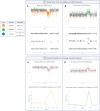This is a preprint.
CNV-Finder: Streamlining Copy Number Variation Discovery
- PMID: 39605431
- PMCID: PMC11601614
- DOI: 10.1101/2024.11.22.624040
CNV-Finder: Streamlining Copy Number Variation Discovery
Abstract
Copy Number Variations (CNVs) play pivotal roles in the etiology of complex diseases and are variable across diverse populations. Understanding the association between CNVs and disease susceptibility is significant in disease genetics research and often requires analysis of large sample sizes. One of the most cost-effective and scalable methods for detecting CNVs is based on normalized signal intensity values, such as Log R Ratio (LRR) and B Allele Frequency (BAF), from Illumina genotyping arrays. In this study, we present CNV-Finder, a novel pipeline integrating deep learning techniques on array data, specifically a Long Short-Term Memory (LSTM) network, to expedite the large-scale identification of CNVs within predefined genomic regions. This facilitates efficient prioritization of samples for time-consuming or costly subsequent analyses such as Multiplex Ligation-dependent Probe Amplification (MLPA), short-read, and long-read whole genome sequencing. We incorporate four genes to establish our methods-Parkin (PRKN), Leucine Rich Repeat And Ig Domain Containing 2 (LINGO2), Microtubule Associated Protein Tau (MAPT), and alpha-Synuclein (SNCA)-which may be relevant to neurological diseases such as Alzheimer's disease (AD), Parkinson's disease (PD), Progressive Supranuclear Palsy (PSP), or related disorders such as essential tremor (ET). By training our models on expert-annotated samples and validating them across diverse cohorts, including those from the Global Parkinson's Genetics Program (GP2) and additional dementia-specific databases, we demonstrate the efficacy of CNV-Finder in accurately detecting deletions and duplications. Our pipeline outputs app-compatible files for visualization within CNV-Finder's interactive web application. This interface enables researchers to review predictions and filter displayed samples by model prediction values, LRR range, and variant count in order to explore or confirm results. Our pipeline integrates this human feedback to enhance model performance and reduce false positive rates. Through a series of comprehensive analyses and validations using visual inspection, MLPA, short-read, and long-read sequencing data, we demonstrate the robustness and adaptability of CNV-Finder in identifying CNVs with regions of varied size, probe density, and noise. Our findings highlight the significance of contextual understanding and human expertise in enhancing the precision of CNV identification, particularly in complex genomic regions like 17q21.31. The CNV-Finder pipeline is a scalable, publicly available resource for the scientific community, available on GitHub (https://github.com/GP2code/CNV-Finder; DOI 10.5281/zenodo.14182563). CNV-Finder not only expedites accurate candidate identification but also significantly reduces the manual workload for researchers, enabling future targeted validation and downstream analyses in regions or phenotypes of interest.
Keywords: Copy Number Variation (CNV); Python; Structural Variant (SV); deep learning; genetics; long short-term memory (LSTM); pipeline.
Figures






References
-
- Lin C.-F., Naj A. C. & Wang L.-S. Analyzing copy number variation using SNP array data: protocols for calling CNV and association tests. Curr Protoc Hum Genet 79, 1.27.1–1.27.15 (2013).
-
- Ahmad A., Nkosi D. & Iqbal M. A. Microdeletion or Duplications Have Been Implicated in Different Neurological Disorders Including Early Onset Parkinson Disease. Genes (Basel) 14, (2023).
Publication types
LinkOut - more resources
Full Text Sources
Miscellaneous
